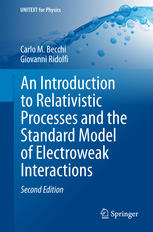

Most ebook files are in PDF format, so you can easily read them using various software such as Foxit Reader or directly on the Google Chrome browser.
Some ebook files are released by publishers in other formats such as .awz, .mobi, .epub, .fb2, etc. You may need to install specific software to read these formats on mobile/PC, such as Calibre.
Please read the tutorial at this link: https://ebookbell.com/faq
We offer FREE conversion to the popular formats you request; however, this may take some time. Therefore, right after payment, please email us, and we will try to provide the service as quickly as possible.
For some exceptional file formats or broken links (if any), please refrain from opening any disputes. Instead, email us first, and we will try to assist within a maximum of 6 hours.
EbookBell Team

5.0
48 reviewsThis book offers a self-contained introduction to the theory of electroweak interactions based on the semi-classical approach to relativistic quantum field theory, with thorough discussion of key aspects of the field. The basic tools for the calculation of cross sections and decay rates in the context of relativistic quantum field theory are reviewed in a short, but complete and rigorous, presentation. Special attention is focused on relativistic scattering theory and on calculation of amplitude in the semi-classical approximation. The central part of the book is devoted to an illustration of the unified field theory of electromagnetic and weak interactions as a quantum field theory with spontaneously broken gauge invariance; particular emphasis is placed on experimental confirmations of the theory. The closing chapters address the most recent developments in electroweak phenomenology and provide an introduction to the theory and phenomenology of neutrino oscillations. In this 2nd edition the discussion of relativistic scattering processes in the semi-classical approximation has been revised and as a result intermediate results are now explicitly proven. Furthermore, the recent discovery of the Higgs boson is now taken into account throughout the book. In particular, the Higgs decay channel into a pair of photons, which has played a crucial role in the discovery, is discussed.
As in the first edition, the accent is still on the semi-classical approximation. However, in view of the necessity of a discussion of H !, the authors give several indications about corrections to the semiclassical approximation. Violation of unitarity is discussed in more detail, including the dispersion relations as a tool for computing loop corrections; the above-mentioned Higgs decay channel is illustrated by means of a full one-loop calculation; and finally, loop effects on the production of unstable particles (such as the Z0 boson) are now discussed. Finally, the neutrino mass and oscillation analysis is updated taking into account the major achievements of the last years.